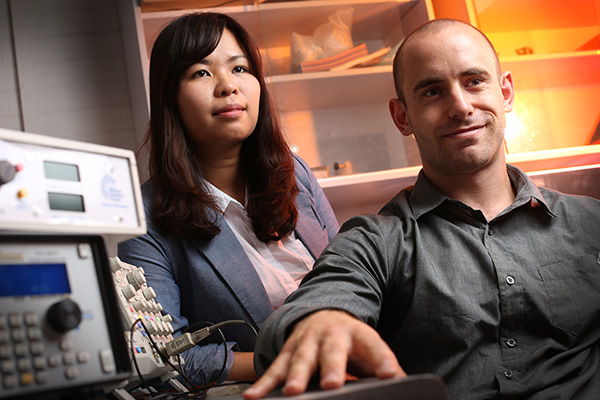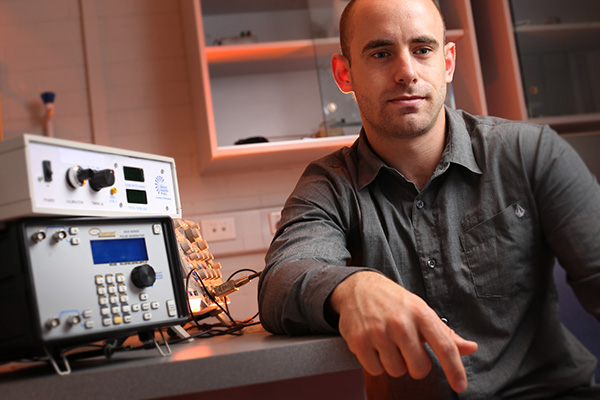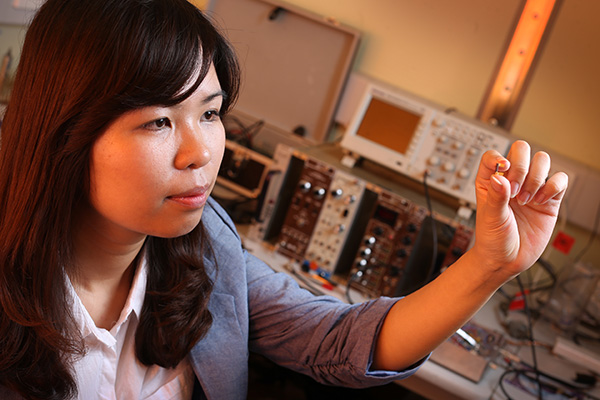December 9, 2014
Cancer and space research radiates success
Researchers at the Centre for Medical Radiation Physics (CMRP) have been recognised for their contributions to developing devices that will make cancer treatment and space travel safer for humans.

Research achievements in microdosimetry – the field of predicting radiation dosages with particular applications for cancer therapy as well as space and aviation – culminated in major awards to PhD students Jeremy Davis and Linh Tran (pictured above).
CMRP has pioneered and patented solid-state devices to measure radiation effects and is a leading contributor to research in the field.
Jeremy Davis and Linh Tran were earlier this year awarded prestigious Phelps Grant Awards from the Nuclear Space and Radiation Effect Conference, hosted by the Institute of Electrical and Electronics Engineers (IEEE) Nuclear Physics and Plasma Science Society (NPSS) in Paris.
The conference is a premier world event bringing together the latest research and researchers involved with radiation effects on humans and electronics in space.
Jeremy Davis was awarded for his outstanding work on the development of a diamond radiation detector, called a microdosimeter, under the supervision of Professor Anatoly Rozenfeld and Dr Susanna Guatelli.
Jeremy is involved in all aspects of the project, taking a leading role in the design, development and testing of the device, which will be used to accurately measure and predict the radiation health hazards that pose a danger to manned space travel.

“Galactic cosmic rays and solar particle events are serious radiation health hazards for space crews,” he said. “There is a need for accurate detectors capable of measuring the dose typical of a space environment. I design, fabricate and test these devices for use in space.”
Linh Tran’s research and development of silicon radiation detection devices for microdosimetry is helping to improve cancer treatment under supervision of Professor Anatoly Rozenfeld.
Her silicon detectors are used to predict the radiobiological effect of radiation doses on a patient treated with charged particle radiation therapy, such as with protons or heavy ions, allowing accurate treatment and better dose planning.
The device, similar to diamond-based detectors, can be used for radiation protection in space and aviation.
“We need to know how much radiation to deliver to kill the cancer cells while improving the quality of life for the patient,” she said. “These detectors will show the biologically relevant impact of radiation on the patient will experience.”
The quality of Linh’s research also was recognised by the New South Wales branch of the Australian Institute of Physics (AIP) where she was awarded the Jak Kelly Prize for excellence in research at its annual postgraduate awards day last month.

Linh has started work as a postdoctoral researcher with CMRP where she is investigating heavy ion therapy for cancer patients. The technique involves directing beams of particles called ions at cancer cells. The ions can be precisely targeted to the location and size of the tumour, limiting damage to surrounding healthy tissue.
A Memorandum of Understanding (MoU) was this year signed between UOW and the prestigious Japanese National Institute of Radiological Sciences (NIRS) that will allow the two institutes to share research, training, facilities and researcher exchanges.
CMRP Director Professor Anatoly Rozenfeld, who this year was awarded the Vice-Chancellor’s Award for Outstanding Achievement in Research Commercialisation as well as the Vice-Chancellor’s researcher of the Year award (joint), said the awards were international recognition of the quality of CMRP academics, research and student mentoring at CMRP.
“It is a great satisfaction and reward for the effort of the group,” he said. “The research at CMRP has tangible outcomes in development of innovative radiation detection instrumentation for error-free cancer treatment and the improvement of quality of life.”